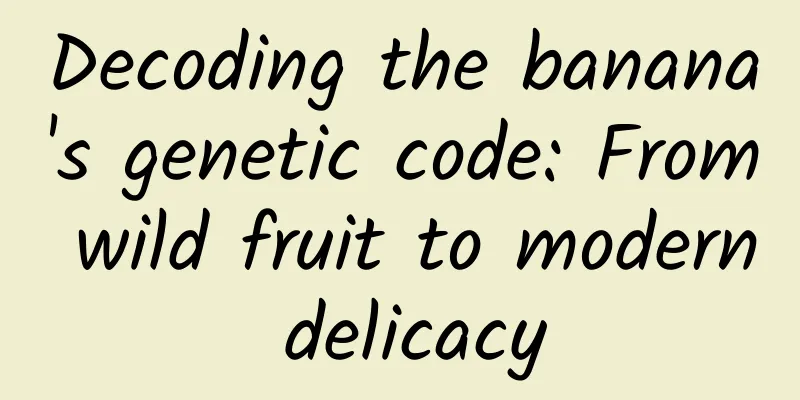Decoding the banana's genetic code: From wild fruit to modern delicacy

|
Produced by: Science Popularization China Author: Liu Xin (South China Botanical Garden, Chinese Academy of Sciences) Producer: China Science Expo Banana is a fruit that is so familiar to us in our daily life, but are you sure you are really an "old acquaintance" of it? Banana (Musa spp.), also known as sweet banana, is a large perennial herbaceous flowering plant belonging to the genus Musa in the family Musaceae, Zingiberales, monocotyledonous plants. It is generally believed that bananas originated in Southeast Asia, including India and southern China. Ancient Chinese classics often use bananas, plantains and sweet bananas interchangeably. Detailed records of banana consumption can be found in Volume 10 of Qi Min Yao Shu. Guang Zhi says: "Peel off the skin, it is yellow-white in color, tastes like grapes, sweet and crisp, and also fills people up." It can be seen that bananas were eaten in ancient China, but the taste seems to be far different from the bananas we usually eat, and they have seeds. This is strange, why do the bananas we eat now taste so good, and why is it different from what is recorded in ancient books? Could it be that bananas have evolved secretly without our knowledge? Banana Garden (Photo source: Veer Gallery) Bananas: Not evolved, but domesticated Banana generally refers to wild species of the genus Musa, which are bitter, contain a lot of seeds, and are inedible. The bananas we usually eat generally refer to domesticated cultivated bananas . Strictly speaking, whether it is plantain, banana or sweet plantain, they are all abstract nouns and do not refer to a specific variety, so they are often used interchangeably by modern people. Wild banana with seeds. The left picture shows a wild banana (Musa velutina) with brightly colored peel that automatically bursts open when ripe; the right picture shows the collected seeds of this species. (Photo source: South China Botanical Garden, Chinese Academy of Sciences) So who first thought of domesticating the unpalatable banana into a variety that can be eaten by humans? With the research and analysis of scientists who love to eat and study, people gradually discovered that the New Guinea region may be the earliest banana domestication center , and early cultivation records were found here. Most of the seedless bananas edible today come mainly from two wild varieties: Musa acuminata (scientific name Musa acuminata, AA, mostly with long fruits ) and Musa balbisiana (scientific name Musa balbisiana, BB, mostly with round and plump fruits ). They were formed through intra-specific or inter-specific hybridization, which led to the production of a variety of modern cultivated bananas. The left picture shows the fruit of the banana plant; the right picture shows the fruit of the banana plant (Photo source: South China Botanical Garden, Chinese Academy of Sciences) The common cultivated varieties on the market are triploids produced by artificial hybridization, mainly including three categories: banana (AAA), plantain (AAB) and pink banana (ABB) . Banana (left), plantain (middle), pink banana (right) (Photo source: Veer Gallery) They are parthenocarpic, which means that they can produce fruit without pollination. Since they have no seeds, they are generally grown in large quantities using tissue culture. You may understand why people sterilize bananas to remove the black seeds and make them taste better. The black dot in the middle is the seed coat left over from seed degradation. (Photo source: Veer Gallery) Bananas are widely eaten Although we usually regard bananas as a delicious fruit after meals, the edible aspects of bananas are far more than that. According to incomplete statistics, there are less than 100 wild banana species, but there are up to 1,000 cultivated banana species. These species are widely planted in about 140 countries, mainly for their fruits. For those who prefer less delicious fruits, they can consider making wine , such as banana beer and banana wine. Not only that, the pseudostems and leaves of cultivated bananas can also produce fiber , and the roots can accumulate a lot of starch . In some underdeveloped countries, bananas are still an important food reserve for people . Although some banana varieties are not suitable for fresh consumption, they are low in sugar, low in water, rich in fiber, and have a rough taste when eaten raw, but after cooking (such as steaming, boiling, baking and frying), they can still become delicious on the table, and are even used as a staple food in some African countries. Plantain Puffs: A Popular African Street Snack (Photo source: Veer Gallery) These cooking bananas, generally belonging to the A. albizia (AAB) family, produce fruit year-round and are extremely durable, making them a valuable food source during famines. We don't just eat bananas. Of course, scientists' research on bananas is not limited to the word "eat". With the rise and development of the research field of genomics, scientists have been conducting genome research on fruit crops since 2007, exploring the genetic secrets of fruits such as grapes, papayas, apples, and woodland strawberries. Timeline of sequencing of important fruit crops (Image source: Reference [1]) The first banana genome, strictly speaking the first wild plantain (Musa acuminata) genome, was sequenced in 2012, greatly facilitating downstream functional breeding research. The first Musa acuminata genome was published in Nature in 2012 (Image source: Reference [2]) In the following 10 years, many studies on the genome of wild bananas were published, but no reference genome of cultivated bananas has been released . Cultivated bananas are often polyploid, with high heterozygosity and repetitive sequence content , so genome analysis is not easy. In August 2022, ten years after the release of the first wild banana genome, a research team from the South China Botanical Garden, Chinese Academy of Sciences, planned to carry out a whole-genome study of cultivated banana (AAA), aiming to reveal the whole-genome genetic composition of cultivated banana and lay a research foundation for tracing the genetic ancestors of cultivated banana and identifying key domestication traits. The variety chosen by the research team belongs to the Cavendish banana family. This variety is widely grown around the world, accounting for about 50% of the market share. There have been previous studies on the Cavendish banana genome, but the resolution and completeness are insufficient. Scientists are eagerly looking forward to the analysis of the complete reference genome of the Cavendish. Why is it delicious but not disease-resistant? Whole genome information can help us better understand the domestication process. Which genes play a key role in the flavor formation of cultivated bananas? Why is cultivated banana generally less disease-resistant than wild bananas? With these questions in mind, the research team conducted further research and found that the gene family related to fruit quality and flavor has expanded significantly, including the sucrose/disaccharide/oligosaccharide metabolism pathway, starch metabolism pathway, and aromatic substance synthesis pathway. In other words, they are involved in the formation of the sweetness, soft and glutinous taste, and aroma of banana fruit. The huge difference in taste and flavor between fresh bananas and cooking bananas may be controlled by these genes. Fresh bananas tend to taste sweeter, which is related to the accumulation of soluble sugars during fruit ripening. Brazilian banana in South China Botanical Garden (Photo source: South China Botanical Garden, Chinese Academy of Sciences) Although domesticated bananas have a better flavor, wild varieties have shown to be more resistant to diseases . This is not unique to bananas; most crops tend to show a decrease in disease resistance during domestication, mainly due to the gradual homogenization of genetic components during the domestication process . Especially for bananas, due to the special asexual reproduction mode, Brazilian bananas around the world may all originate from the same individual and have the same set of DNA. If an individual is susceptible to a certain disease, then all individuals will be susceptible. Fusarium wilt is an example, which caused the globally popular barley variety to fade out of the market in the previous generation. Unfortunately, in recent years, it has been found that Brazilian bananas are also susceptible to Fusarium wilt. The researchers tested the entire genome for disease resistance loci and found that there were fewer resistance genes in Brazilian banana compared to wild banana. This is consistent with traditional knowledge, but considering the monophyletic origin of Brazilian banana (their resistance genes are directly inherited from the parents, so the resistance genes should be consistent with the parents), this result is surprising. Researchers believe that the complex domestication process of Brazilian banana may have caused this uniqueness. In addition, the researchers also located the regions associated with wilt resistance on chromosomes 3 and 10, which pointed out the direction for future wilt research. Conclusion Understanding the domestication process of crops is often not simple. For example, the origin of Asian rice (also known as rice) has long been controversial. The successful analysis of the triploid banana genome provides an important resource for banana genetics and breeding. Determining the ancestors and domestication process of cultivated bananas is another extremely important task, which will help us understand the formation of banana diversity, which is the key to future banana breeding. In the future, botanists will combine large-scale germplasm resource surveys with population-level research (comparing similarities and differences between individuals and groups) to further clarify the origin process of domestication of cultivated bananas, so that breeders can select suitable varieties for hybridization. The tiny banana contains the secrets of human domestication of fruits. In the future, botanists will reveal more domestication secrets to us. Are you looking forward to it? References: [1]Wang R, Li X, Sun M, et al. Genomic insights into domestication and genetic improvement of fruit crops[J]. Plant Physiology, 2023: kiad273. [2] D'hont A, Denoeud F, Aury JM, et al. The banana (Musa acuminata) genome and the evolution of monocotyledonous plants[J]. Nature, 2012, 488(7410): 213-217. |
<<: What is shore power? The quality of port air is actually related to it!
>>: A "paper airplane" that can be folded in one hour destroyed a fighter jet worth $100 million...
Recommend
Fast and Furious 7? Coocaa K50J one-week gaming trial
The high-end modified car dealership invested by ...
Use this "retention rate model" to calculate how far your product is from making a million a day?
Almost all operational work is carried out around...
How can a designer with no programming knowledge develop an app in 4 months?
Transcend dry goods: The author of this article i...
One person infected can infect the whole family. If you have these symptoms, you need to see a doctor as soon as possible.
Recently, Jiangsu Province released the "Jia...
Based on React and Vue, how does the mobile open source project Weex define the future?
[51CTO.com original article] This year, many peop...
A cheap iPhone X at half the price won't save Apple
Like the iPhone SE, the iPhone X, which has been ...
What to do when a programmer is tired
It is not uncommon for programmers to lose their ...
Let the data speak for itself: What will be the next phenomenal APP?
The explosion of WeChat public accounts has broug...
World Snow Leopard Day | Isn’t it embarrassing for such a majestic cat to meow like this?
Let’s first listen to how the “embarrassing” big ...
This is how products with over 100 million users retain users
The content of this article is a summary after ac...
Fudan University Liang Yongan: Hardships of Work
Liang Yongan from Fudan University: The Hardship ...
China Automobile Dealers Association: A brief analysis of the used car market in June 2024
Overall performance of the used car market in Jun...
Is the franchise fee of Mudanjiang Steel Mini Program high? Mudanjiang Steel Mini Program Franchise Fees and Process
How much does it cost to join the Mudanjiang Stee...
AI and scientists work together to uncover the charred "scroll" under Mount Vesuvius
Author: Duan Yuechu In the long river of history,...
To prevent “egg head rot”, who is the “flower protector” of Songhua preserved eggs?
Songhua preserved eggs have a unique flavor and a...









